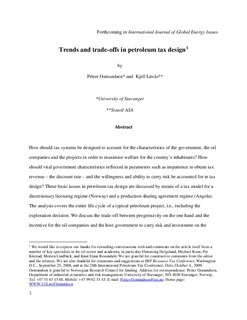| dc.contributor.author | Osmundsen, Petter | |
| dc.contributor.author | Løvås, Kjell | |
| dc.date.accessioned | 2017-10-03T08:23:59Z | |
| dc.date.available | 2017-10-03T08:23:59Z | |
| dc.date.created | 2014-01-29T14:34:56Z | |
| dc.date.issued | 2013-08 | |
| dc.identifier.citation | Osmundsen, P.; Løvås, K. (2013) Trends and trade-offs in petroleum tax design. International Journal of Global Energy Issues, 36 (1), 42-60. | nb_NO |
| dc.identifier.issn | 0954-7118 | |
| dc.identifier.uri | http://hdl.handle.net/11250/2457962 | |
| dc.description.abstract | How should tax systems be designed to account for the characteristics of the government, the oil companies and the projects in order to maximise welfare for the country's inhabitants? How should vital government characteristics reflected in parameters such as impatience to obtain tax revenue - the discount rate - and the willingness and ability to carry risk be accounted for in tax design? These basic issues in petroleum tax design are discussed by means of a tax model for a discretionary licensing regime (Norway) and a production sharing agreement regime (Angola). The analysis covers the entire life cycle of a typical petroleum project, i.e., including the exploration decision. We discuss the trade-off between progressivity on the one hand and the incentive for the oil companies and the host government to carry risk and investment on the other. Thus, we provide basic elements in a state contingent tax design. The paper also surveys trends in petroleum taxation, and discusses how tax elements vary over the business cycle. | nb_NO |
| dc.language.iso | eng | nb_NO |
| dc.publisher | Inderscience Publishers | nb_NO |
| dc.subject | petroleum tax | nb_NO |
| dc.subject | oljeindustrien | nb_NO |
| dc.subject | skatt | nb_NO |
| dc.title | Trends and trade-offs in petroleum tax design | nb_NO |
| dc.type | Journal article | nb_NO |
| dc.type | Peer reviewed | nb_NO |
| dc.description.version | acceptedVersion | nb_NO |
| dc.rights.holder | Inderscience | nb_NO |
| dc.subject.nsi | VDP::Social science: 200::Economics: 210 | nb_NO |
| dc.source.pagenumber | 42-60 | nb_NO |
| dc.source.volume | 36 | nb_NO |
| dc.source.journal | International Journal of Global Energy Issues | nb_NO |
| dc.source.issue | 1 | nb_NO |
| dc.identifier.doi | 10.1504/IJGEI.2013.055940 | |
| dc.identifier.cristin | 1103518 | |
| dc.relation.project | Norges forskningsråd: 230303 | nb_NO |
| cristin.unitcode | 217,8,3,0 | |
| cristin.unitname | Institutt for industriell økonomi, risikostyring og planlegging | |
| cristin.ispublished | true | |
| cristin.fulltext | postprint | |
| cristin.qualitycode | 1 | |
